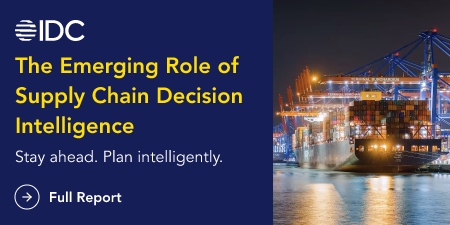
Author: Zehra Melis Teksan
Good decision making is the cornerstone of any successful company. This is especially true in today’s supply chain world, where each and every day companies must make countless, crucial decisions (under great pressure and uncertainty) about everything from demand forecasting and order promising to capacity management and raw material utilization to network design and shipment planning.
All these decisions trigger actions, which have an impact on each company’s performance against their key performance indicators (KPIs) and ultimately their progress towards their business goals.
So how do supply chain companies make these all these everyday, high-stakes business decisions? What is their decision-making process?
The gap between data and decisions
Most supply chain companies rely on their real-time and historical data – which is collected via various sources including ERP systems and IoT devices and presented to them in Excel-based reports and plans – to guide them in their decision making.
Typically what happens is that planners and key stakeholders look at their plans (which are either manually created or generated by a planning software solution), and then try to use these plans to make strategic, tactical, and operational decisions – and this is where the problems arise.
This is because, in many instances, these plans are not accurate or even feasible (let alone optimal). Planners and other key stakeholders examine and assess their plans and think, “I can’t do this” or “I shouldn’t do that” – or something along those lines. They find themselves in limbo, literally looking at their plans and unable to decide what to do.
Usually, instead of simply trusting and following their plans, planners and other key stakeholders – using their own ideas, insights, experiences, and gut feelings – manually adjust their plans and make their own decisions and take action accordingly.
And this is how the “decision-making gap” – the disconnect between what supply chain companies’ data and plans are telling them to do and what they actually decide to do – is formed.
The result of this decision-making gap is that plans and business decisions are not driven by data and not aligned with KPIs and business goals – and this, in the supply chain world, leads to subpar productivity, delivery performance, and profitability.
Bridging the decision-making gap
So how can supply chain companies eliminate the gap between their data and their decisions? How can they use the output of their data collection and planning systems as direct input for their decisions?
Algorithmic supply chain planning and decision-making optimization solutions, like ICRON, give supply chain companies the power to instantly transform their data into optimized plans and decisions – thereby eliminating the decision-making gap and achieving a state of “decision-centric optimization”.
Unlike other supply chain planning software providers, which are solely focused on collecting data and generating plans, ICRON models the actual decision processes within a supply chain company in such a way that the plans actually make sense and can be used to make decisions.
Utilizing data, algorithms, and organizational input, ICRON provides an integrated, automated planning platform that enables each company’s planners and other key stakeholders to:
- Instantaneously make optimized strategic, tactical, and operational decisions that trigger optimized, real-time actions.
- Immediately see the results of their decisions and gauge their impact on ongoing operations and business objectives.
- Explore the potential effects of alternative decisions by conducting “what-if” scenario analysis.
With ICRON, planners and other key stakeholders can have complete confidence in their plans and use them to instantly make optimized decisions – fueled by data, integrated with their decision-making processes, and aligned with their KPIs and business goals.
With ICRON, supply chain companies can close the decision-making gap and open the door to a world of opportunities for optimization of planning and decision making.
If you would like to see ICRON in action, please contact us. If you have enjoyed this blog, you can find more content that you might enjoy here.













